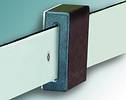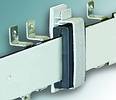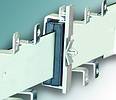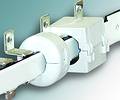

In industry, there are increasing needs to both improve performance and speed of electronic systems, as well as cut assembly costs.
The requirements are doubly important for power transmission, IGBT and other larger systems. Next generation hybrid and fuel cell vehicles will eliminate wiring harnesses in favour of the bus-bar.
Bus-bars are the wave of the future for lower cost, higher reliability and error-free circuit board layouts. They are an elegant solution to messy cables snaking across boards. They are a very low impedance, highly efficient way to move power and data around in a 'box' or a rack of varying subsystems. Made of copper and various dielectrics, they are almost always 'customs', and the more complex bars have around 10-15 alternating layers, with power and data taps placed as needed.
Because they can act as an antenna, some effort must be made to control EMI noise.

The problem
As mentioned, bus-bars are very low impedance devices, and they are also very efficient antennas. They pick up noise coming from active components on a board, or from the surrounding environment. Because there is usually plenty of power on the bus-bar, they then can amplify and re-radiate the low energy noise to the point that it becomes a major EMC problem.
Some innovative engineers worked out that rectangular ferrite sleeves might be an efficient solution, albeit a custom one. Solid and split rectangular ferrites are common EMC noise solutions for flat-ribbon cables, but those cables are usually quite thin. A bus-bar is usually 3 to 10 mm thick. Since no industry standard ferrite parts would fit around the much larger bus-bars, custom tooling had to be made, and parts run especially for each size of bus-bar.

A large part of the cost of a split rectangular ferrite is in the tooling for the plastic straps and carriers, making custom ferrites a solution for only the largest volume applications. Some bus-bar manufacturers got around this problem by ordering custom ferrites made to fit the bus-bars - only a moderate investment of tooling. They then had to glue and tightly clamp the split halves of ferrite together around the bus-bars. This process takes a lot of labour, fixtures to hold the ferrites and 24 hours of curing time - a very expensive process. Also, some ferrite parts are prone to fatal cracks during the pressure of the curing process.

The 4-second solution
FerriShield addressed the problem in a unique way. Its engineers developed a universal set of split, large aperture, bus-bar clamps. They held down costs by using already-developed ferrite ribbon-cable parts and plastic clamps. Sizes have been adjusted to fit the much larger bus-bars. These are now standard parts available from stock, just as is any other FerriShield product.
These new designs incorporate FerriShield's popular press fit and adhesive foam-mounting techniques, which allow the bus-bar maker another insulated mounting point that they often need. FerriShield has also built up lower cost rectangular solid core parts for bus-bars that simply slide onto an open-ended bar. These are usually secured in place with shrink tubing, hot-melt glue or double-stick tape.
In either case, the FerriShield solution is about a 4-second assembly. There are no other tools or time needed for this very efficient means of noise suppression on a bus-bar. FerriShield also offers quick-turn machining to allow its standard catalogue parts to fit many bus-bar geometries and their mounting requirements. A properly-placed ferrite noise suppressor will attenuate unwanted high-frequency signals, thus negating the conductor and/or antenna-like radiating effects at specific frequencies, whilst not disturbing the power distribution characteristics of the bus-bar.
For more information contact Connecta, 011 463 2240, [email protected].

© Technews Publishing (Pty) Ltd | All Rights Reserved